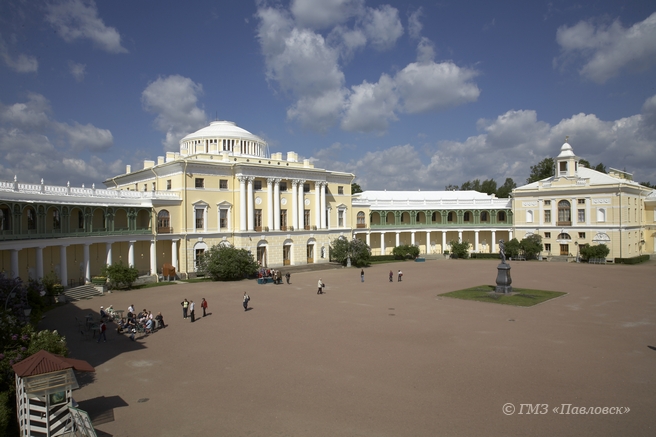Pavlovsk Palace

The centrepiece of the Pavlovsk ensemble is the Great Palace, a marvellous specimen of Russian Classicism of the late eighteenth and early nineteenth centuries. It was built by Charles Cameron between 1782 and 1786. Being an admirer of the antique art, Cameron lent to all his creations an air of classical austerity and elegance. Comparatively small, the Great Palace didn't startle by its dimensions or by sumptuousness of its decor, it grips imagination with its perfect harmony, proportionality and elegance. The interior decoration was in keeping with the austere architecture of the building.
When Paul I ascended the throne, this simplicity could no longer satisfy him and he commissioned Vincenzo Brenna to enlarge the complex. The new architect substantially altered the exterior and interior of the palace, imparting to it a stately and solemn appearance. He added a gallery, extended the sevice blocks and attached a chapel, as a result of which the main courtyard became almost enclosed. Brenna adorned the facades with decorative stuccowork in the form of knights' armour and created a suite of new state apartments - the Throne Hall, the Hall of Gentlemen in Waiting, the Picture Gallery, the Hall of War, the Hall of Peace and others.
After the death of Paul I the mistress of the imperial residence was Maria Feodorovna, the late emperor's widow. The building works were carried on up to the 1820s. Such eminent architects as Carlo Rossi, Giacomo Quarenghi, Andrey Voronikhin, Thomas de Thomon, the sculptors Ivan Martos, Fiodor Gordeyev and others contributed to the decoration of Pavlovsk.
Especially great was the role of Andrey Voronikhin who was in charge of reconstruction works in the palace after the fire of 1803. He not only revived the gutted interiors but built his famous Little Lantern as well.
Working on the interiors of the palace was also the brilliant decorator and landscape designer Pietro Gonzaga. After the 1830s no additions of any importance were made to the decoration of the Pavlovsk Great Palace.
Soon after the October Revolution (1917) Pavlovsk was converted into an art and history museum, the doors of the Pavlovsk Great Palace were thrown open to the people, and it became one of the most visited museum complexes.
During the War of 1941-1945 Pavlovsk suffered tremendous damage. The town was occupied by the Nazis, who plundered the palace, destroyed many pavilions and felled nearly 70,000 trees. Before retreating they burnt the palace down.
Restoration and reconstruction work was begun immediately after the war. Many decades seemed to be needed to restore the complex. This giganic work is now close to its completion. Nowadays thousands of Russian and foreign visitors come to see Pavlovsk reborn and beautiful as ever.
